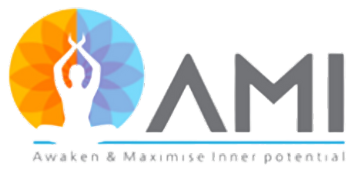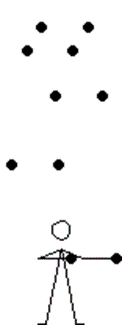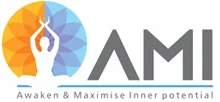Do you:
- feel enthralled watching Ronaldo hit a goal in a ‘win or lose’ penalty shot or in a cricket match when the ball is hit high up in the air with the entire audience holding their breath till the fielder takes that impossibly difficult catch?
- feel awed and inspired when you listen to an impressively flawless business presentation?
- envy the complex steps executed in a contemporary dance performance?

One of the ways to help enhance these skills is by practice of Neuro Yoga !
Introduction:
Neuro yoga is a type of mind-body coordination practice that uses a combination of muscular activity and focus on body movements with breath. Such practices could enable the brain and its neural connections to become speedier and more efficient, improving spatial perception and other cognitive abilities including memory and sensory skills.
The practice consists of sequences that stimulate the neuro muscular systems thus maintaining and strengthening brain health. These include balancing, hand-eye coordination and memory enhancing skills. Balancing postures not only build strength but also proprioception, for example, when you reach across a table to grab a pencil, you use proprioception to know how much to move the muscles in your arm in order to make that motion. You also use spatial awareness to gauge the distance between yourself and the pencil.
Additionally, breathing and pranayama practices aimed at specifically targeting the head region along with an increase in breathing capacity provide the extra dose of oxygen needed by the brain to help enhance the health of brain tissue.

Overview:
- The brain is primarily made up of two types of tissues viz. grey and white matter. Grey matter consists of neurons and is responsible for learning, memory ,sensory perception, muscle control etc and the white matter are the connections that extend from grey cells to different sections of the brain. Damage to either grey or white matter impacts brain activity i.e., both complement one another on thinking, movement etc. Similarly, in neuro yoga, constant use and practice of control in balancing postures, breathing, and mental activity has possibility to result in increased grey matter density and activation. This improves focus , concentration and critical thinking skills enabling better decision making !
- The human brain is divided into 2 hemispheres the left and the right. Although both the cerebral hemispheres are similar, some of their functions differ. The right hemisphere controls the left side of the body. It makes you creative, spontaneous and deals with feelings and emotions. The left hemisphere is the logical side which makes one analytical and rational.
- It has often been said that people are usually dominant on one side and that defines their characteristics. Creative people tend to have a dominant right-side brain while organized and disciplined people have a dominant left-side brain. Practices like Neuro yoga make it possible for people with a dominant side to achieve balance by improving the other side of the brain.
- People do things daily that cause deterioration of the brain and nervous system. How does this happen? Neurons are tiny cells in the brain in charge of participating in the functions related to the nervous system. The brain, contains millions of neurons, scientists calculate that we have about 80 million when we are born. As we grow, this number decreases. An 80-year-old will have lost 30% of their neurons. Throughout our life, we constantly lose and regenerate them.
- Most people have heard the phrase “use it or lose it”, which is generally applied to physical exercise and the same principal can be applied in case of neurons. By the neuron regeneration process, new connections are made and this process allows for the birth of new brain cells throughout a person’s life.
- For children Neuro yoga practices work through a range of muscles in the body, thus helping improve body coordination and encouraging motor development too. When a baby makes their first movements they are developing spatial reasoning skills.
- Research involving a comprehensive study of structural brain scans found that a person’s general intelligence is associated with the volume of grey matter in that specific area of the brain. Example: London black cab taxi drivers are reputed for their knowledge of local streets and their ability to navigate around traffic. Correspondingly, these individuals have higher volume of grey matter in their hippocampus, which is responsible for memory and spatial navigation.
Professional musicians on the other hand present more grey matter in the motor, auditory, and visuospatial regions of the brain. ‘Spatial’ is defined as the ability to see and understand the relationships between shapes, spaces, and areas.
Neuro yoga practices consist of balancing warm ups like walking on heels and toes and cross-lateral (cross-crawl) movements by using opposite sides of the body to work together. The practices are designed asymmetrical to get both hemispheres of the brain to work on them.
- Stand with your feet apart and arms stretched out to the front, palms parallel to the floor. Lift your right knee and touch it with your left hand and repeat on the other side. Do it rhythmically and try to gradually increase the pace of the practice. Anytime the left and right side of our bodies work simultaneously or one side of our body crosses the midline over to the other side, the brain is compelled to send signals back and forth from one side to the other. The more times we do this, the stronger these connections become.
- Additional practices below:
Tadasana: gets its name from the Sanskrit words Tada meaning a palm tree and asana, meaning posture. Tadasana stretches the arms, the chest, the abdominal muscles, the spine and the leg muscles. This is a variation of the Tadasana to stimulate the cortical muscles.
Precautions: Tadasana should not be performed if you experience giddiness or suffer from vertigo, low blood pressure or have a severe headache.
Technique
- Stand with the four corners of your feet planted firmly on the ground, close to each other.
- Straighten the hands by the sides of your body & focus your attention to a point in front.
- Raise your heels and at the same time stretch the arms upwards, balancing on your toes.
- In the above pose, make a fist of the right hand and keep the fingers of the left hand stretched out. Now, straighten the thumb of the right hand and curl the thumb of the left hand and repeat the practice with the rest of the fingers. If you feel tired , rest the feet back on the floor and then raise heels back up to continue.
- Reverse – make a fist of the left hand and keeping the fingers of the right hand stretched out. Now straighten the thumb of the left hand and curl the thumb of the right hand and continue similarly with the rest of the fingers.
- Slowly bring the toes back to the floor and the hands down at same time.
Naukasan (boat pose): Nauka means a boat , the final posture resembles a boat. The posture stimulates the muscular, circulatory, digestive, endocrine and nervous systems. It refreshes the brain and infuses vitality. This is a variation to stimulate both cerebral hemispheres. The left hemisphere controls the arm movement and the right hemisphere regulates the arm’s position in space
Precautions: Avoid in case of high BP, and spine or abdominal issues.
Technique
- Lie on the back in the supine position, breathe in deeply. Hold the breath and then raise the legs and head and trunk off the ground.
Shoulders and feet to be 15 cms off the floor. Balance on the sit bones and ensure spine is straight with arms in line with the toes. Keep breathing in the pose.
- Once steadiness is achieved , close both hands into fists and raise the thumb of the right hand and the little finger of the left. Similarly move on to raise index of the right hand and ring finger of the left and continue with the rest of the fingers. Reverse the practice.
Gradually try to increase the pace.
- If tired come back to supine position, rest and then return to the practice. Repeat 2-3 times
- To release the pose, gently return to supine position and slowly rest the head on the mat.
Ardha Halasan (Half plough pose): Ardha’, means ‘Half’ in Sanskrit and ‘Hala’, means ‘Plough’. The practice massages and energizes the brain, heart, lungs and abdomen. It also stabilizes emotions and calms the restless mind.
Precautions: Avoid in case suffering from lower back pain or abdominal issues
Technique:
- Lie on the back in the supine position with hands by the side of the body.
- Bring both feet together and lift both legs up, keeping them straight while inhaling until they are perpendicular to the floor. Hold the feet together in the air and breathe normally.
- Take the hands up until back of the palms are on the floor above the head.
- Raise the left hand vertically and curl fingers and simultaneously stretch the toes of the right foot. Now curl the toes of the right foot and same time stretch out the fingers of the left hand. Do this about 5-6 times and repeat on the opposite side.
- Slowly bring the legs down with exhalation and relax the whole body.
Anulom Vilom (alternate nostril breathing) , an effective Pranayama (breath focus) practice which helps activate the right and left brain and positively influence the cognitive processes. It is one of the best pranayama practices purifying the different energy channels in the body
It cleanses, strengthens and tones the nervous system, which also helps in improving concentration. It also induces tranquillity, clarity of thought and concentration and is recommended for those engaged in mental work. It allows deep breathing and improves lung function
Precautions: Anulom vilom is not to be practised while suffering from colds, flu or fever.
Set the duration of inhalation and exhalation as per your physical strength and fitness, it should not to be done very fast, it is a soundless gentle practice. The best time to practise is early morning or any time of the day on empty stomach.
Technique:
- Sit comfortably on a mat or on a chair. Keep the head and spine upright. Relax the whole body and close the eyes. Bend the index and middle fingers of the right hand and keep the other fingers upright (Pranava mudra) and keep the left hand on the left knee. You use the right thumb to close right nostril and the ring and little finger to close the left nostril.
- Close the right nostril and breathe in from the left nostril. Close both nostrils and hold breath in. Then close left nostril and breathe out from the right nostril.
- Now breathe in deeply with right nostril, close both nostrils, hold breath and then close the right nostril and breathe out deeply with the left nostril. This is one round. Practice 5 to 10 rounds for beginners.
- The time for inhalation and exhalation should be equal initially and with practice the time for exhalation can be longer than inhalation.
Anulom Vilom can be combined with Gayatri Mantra to enhance its effect on the brain
Here are links for more Neuro yoga practices: https://www.facebook.com/198769777123867/videos/270262917131342.
https://amiyogaglobal.com/old/for-enhanced-creativity-productivity-turn-to-neuro-yoga/
Further insight:

- Over the past years, studies have emerged on investigating the effects of exercises like yoga on brain function. The focus was mostly on musculoskeletal and cardiopulmonary benefits with training. These studies indicated that increased task-related activation in the brain is accompanied by an improved motor function.
- Brain stimulating practices like neuro yoga increases the folds in the Brain. If you look up a photo of the human brain, you’ll notice that its surface is made up of bumps and wrinkles. These wrinkles are basically called cortical folds, or gyrification if you prefer a more medical or scientific term. These folds contain your brain cells. These structures play an essential role in your ability to think.
- A form of rehearsal involves motor coordination, whereby movements or series of movements are “memorized” for greater efficiency or skill of execution in the future. Also, the regular practice improves spinal mobility, posture and has positive impact on certain aspects of cognitive functioning. Neuro yoga can be an example of neuromuscular coordination with breath via asanas (postures) on balancing and the 5 types of spinal movements and mental stimulation.
- Spatial perception is important and useful for people of all ages. For example, when we are driving, we have to be careful to stay in our lane and not jump the curb when we park. In these cases, we have to judge the distance, position, and dimension of other objects in relation to ourselves.
- Spatial reasoning skills are thought to be particularly important for many careers. People working in the STEM (Science, Technology, Engineering and Mathematics) fields are thought to have good spatial reasoning skills. Spatial thinking is also important for architecture, graphic design, computer sciences, biology, physics, chemistry, geology, geography and even medicine. Therefore, it is helpful to develop these skills as early as possible in life. The left hemisphere of the brain is in charge of developing this cognitive ability. If spatial perception is frequently exercised as in neuro yoga practices , the brain structures involved in perception will be strengthened and speeded up.
- Neuroplasticity is the capacity of neurons and neural networks in the brain to change their connections and behaviour in response to stimulation like neuro yoga practices or due to damage, or dysfunction. Recent findings indicate that the brain has the capacity to heal itself and regain some lost function through neuroplasticity.
- Scientists know that the active areas of the brain use more energy, and thus use more oxygen and glucose. On the other hand, an inactive brain cell receives less and less blood until it ultimately dies. Also, active brain cells have more connections with other brain cells. The larger the cell’s neuronal network is, the higher the possibility of being activated and surviving.
Neuroscientists have long known that cross-body movements help the left and right hemispheres of the brain to connect and coordinate. This is important because the more your hemispheres connect, the more optimally you perform on any given task. We do it all the time in our everyday activities (walking, climbing stairs, riding a bike etc)
Neuro yoga is a modern practice that can supplement contemporary medicine. Such type of practices are known to strengthen networks in the brain that control mental efficiency. It amplifies coordination, body control and agility by speeding up neuromuscular communication and ups the ability of muscles to react expeditiously.
To learn more, get in touch with us at https://amiyogaglobal.com/old .

<Mohamed Nohasi>
Reference websites / articles:
- Asana, Pranayama, Mudra, Bandha by Swami Satyananda Saraswati
- “Illuminating lives with Yoga” by Ms. Geeta Iyer
- yogamedicine.com/how-yoga-changes-your-brain/
- ncbi.nlm.nih.gov/pmc/articles/ by Stephanie Perry
- cognifit.com/science/cognitive-skills/spatial-perception.
- healthline.com/health/spatial-awareness#why-it-matters
- theconversation.com/
- childreninspiredbyyoga.com/blog/2017/11/develop-spatial-reasoning-skills
- ncbi.nlm.nih.gov/pmc/articles/PMC4061835/http
- deekshalearning.com/blog/7-simple-brain-exercises-to-activate-both-sides-of-your-brain/
- musculoskeletalkey.com/yoga-exercises-respecting-dynamic-neuromuscular-stability-principles-in-senior-populations/
- inc.com/melanie-curtin/want-to-sync-2-hemispheres-of-your-brain-neuroscience
- Asana,
- <Paintings on yoga poses courtesy: ancient yoga drawings welcome collection.org; Pinterest>




